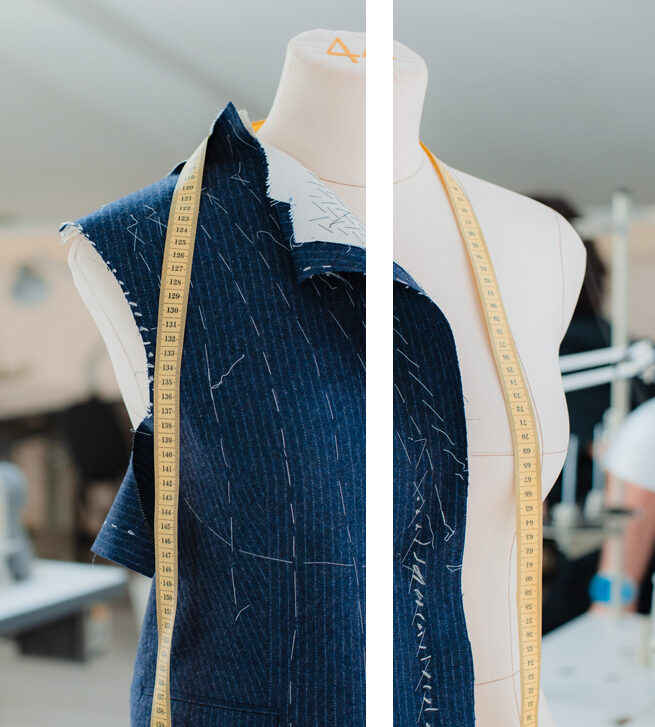Comprehending the Tailoring Process: From Fabric Selection to Last Suitable for the Perfect Closet
The tailoring process is a complex interaction of art and scientific research, starting with the vital decision of fabric selection and finishing in the specific modifications of final fittings. Each textile kind brings distinct qualities that influence not just the aesthetic appeal yet additionally the garment's durability and suitability for various celebrations. Recognizing the nuances of tailoring strategies can raise one's wardrobe to extraordinary degrees of elegance. As we discover these aspects even more, one must take into consideration exactly how even the tiniest details can considerably influence the general outcome of one's individual style.
Relevance of Textile Selection
Selecting the appropriate fabric is critical in the tailoring process, as it straight affects the convenience, sturdiness, and total visual of the final garment (tailor perth). The selection of material establishes the structure for the garment's style, performance, and functionality. Different materials have special homes, such as stretch, breathability, and weight, which can substantially impact exactly how the garment drapes and fits the body
Additionally, material option affects the garment's durability and simplicity of care. Top quality fabrics can endure wear and tear, maintaining their look and framework gradually, while lower-quality materials may result in pilling or fading. Additionally, the right fabric adds to the garment's capacity to shift across celebrations and periods, consequently improving adaptability.
A tailored item made from an ideal material not only showcases workmanship yet likewise elevates the user's confidence. Recognizing the nuances of textile selection is paramount for any customizing venture. It ensures that the end product not just satisfies the visual wishes of the client however also straightens with functional needs, thus attaining a harmonious equilibrium between type and function in the customized closet.
Types of Fabrics and Their Usages
Comprehending the numerous kinds of textiles available is essential for making informed choices throughout the tailoring procedure. Each fabric has unique attributes that dictate its suitability for details garments and occasions.
Its adaptability permits it to be customized right into everything from t-shirts to gowns. Its all-natural flexibility aids garments keep form over time.
Silk exhibits high-end and is light-weight, making it best for eveningwear and fragile shirts; nonetheless, it calls for careful handling due to its fragility. Linen, with its textured finish, is a popular choice for warm climates, giving a ventilated and crisp feel, but it wrinkles quickly, which may impact the garment's appearance.
Synthetic fabrics, such as polyester and nylon, offer sturdiness and resistance to creases, making them appropriate for daily wear and active clothes. Comprehending these fabric types and their residential properties permits for much better decision-making, guaranteeing that each tailored item not just fits well however likewise aligns with the intended objective and celebration.
The Tailoring Methods Described
The art of tailoring counts on a selection of strategies that transform fabric right into well-fitted garments. Central to this procedure is pattern preparing, where a tailor develops themes based on the customer's dimensions and desired design. This preliminary step ensures that the garment will certainly fit the wearer properly prior to any type of cutting takes place.
When patterns are established, reducing techniques enter into play. Accuracy is critical as inaccuracies can bring about misfitting garments. Tailors commonly use numerous cutting methods, such as single-layer reducing for elaborate layouts and multiple-layer cutting for performance on common patterns.
Basting is one more crucial method, allowing dressmakers to temporarily sew fabric items together for an initial fitting. This approach provides the possibility to evaluate the drape and total silhouette prior to final stitching.
Seaming strategies, including flat-felled joints and French seams, boost the garment's sturdiness and aesthetic allure. Tailors also use strategies such as interfacing and extra padding to offer framework and shape to certain locations, like shoulders and collars.
Last but not least, finishing methods, consisting of hemming and edge completing, make sure the garment's long life while providing a refined appearance. With each other, these strategies form the foundation of reliable customizing, resulting in charming, tailor-made garments.
Fitting Adjustments and Factors To Consider

Key considerations consist of the shoulder fit, which must neither sag nor limit motion, and the sleeve length, which should permit comfy arm movement while preserving a polished look. Additionally, changes at the midsection can fine-tune the silhouette, with options to allow out or absorb fabric as required.
The increase of trousers is another critical variable; it must sit comfortably over the hips without causing pain, enabling for simplicity of motion. Hemming sizes for both trousers and skirts ought to reflect the user's favored design while valuing percentages.

Preserving Your Tailored Clothes
Correct upkeep of customized garments is important to preserving their fit and appearance in time. To guarantee durability, routine cleaning is critical. Always comply with the care label instructions, which may recommend dry cleansing for fragile textiles or equipment cleaning for even more long lasting products. Prevent frequent laundering, as this can wear down the fabric and alter the garment's form.
Storage space is similarly essential; use cushioned wall mounts for layers and coats to preserve shoulder structure, and store pants folded neatly or hung to stop creasing. Protect garments from straight sunlight, which can fade shades and damages fibers.
Additionally, periodic examinations for minor repairs can protect against bigger issues. Look for loosened switches, tearing joints, or indicators of moth damages, attending to these problems promptly to preserve the garment's integrity.
Last but not least, think about seasonal turning. Using customized pieces in small amounts enables fabrics to recuperate, extending their life expectancy. By implementing these maintenance approaches, you can guarantee that your customized garments continue to be as excellent as the day you first image source wore them, boosting your suitable wardrobe for many years ahead.
Final Thought
The tailoring process, including material choice, knowledgeable techniques, and exact suitable changes, plays a crucial role in producing garments that improve both comfort and style. Comprehending the significance of maintenance prolongs the life of tailored garments, solidifying Full Article their value in a well-curated closet.
Picking the appropriate textile is critical in the customizing procedure, as it straight influences the comfort, durability, and total aesthetic of the last garment. The choice of textile sets the structure for the garment's functionality, design, and efficiency. Different materials possess one-of-a-kind homes, such as stretch, breathability, and weight, which can considerably affect just how the garment drapes and fits the body.
The art of tailoring relies on a selection of methods that change material into well-fitted garments.The customizing process, including material choice, knowledgeable strategies, and specific suitable modifications, plays a critical duty in producing garments that improve both comfort and design.